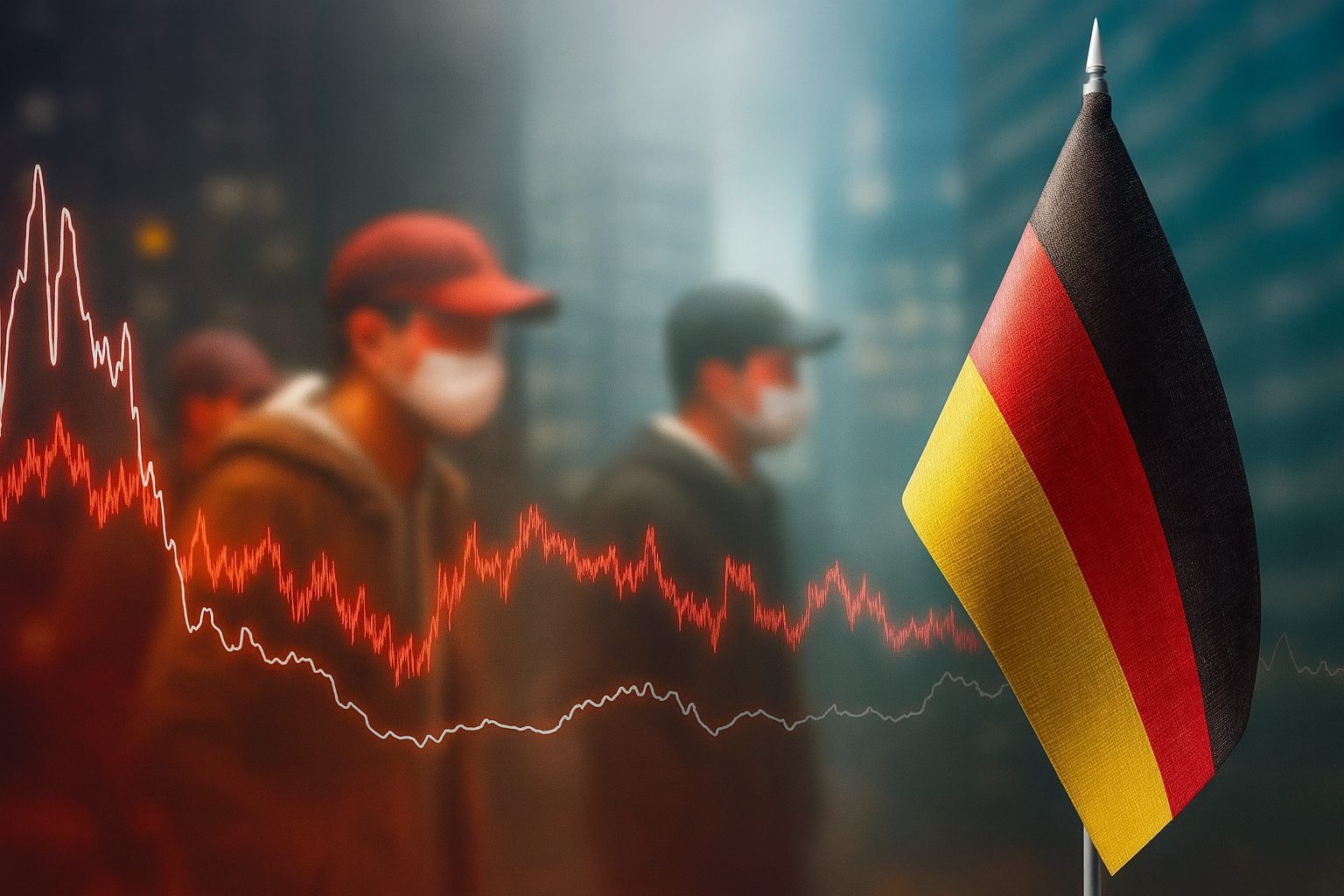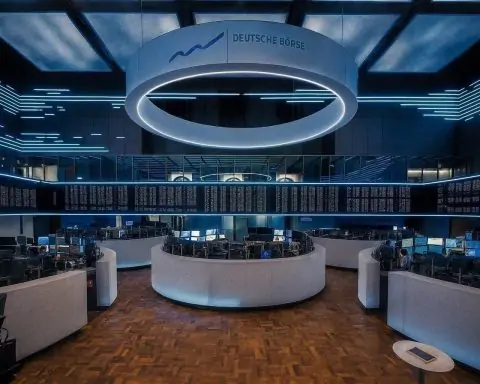Berlin – November 26, 2025
Germany’s latest GDP figures confirm what many households and businesses have felt for years: Europe’s largest economy is still barely moving. The second estimate for third‑quarter 2025 shows zero quarter‑on‑quarter growth, cementing the country’s longest stretch of stagnation in the post‑war era – even as the IMF, Bundesbank and markets start to talk about a tentative recovery in 2026 and beyond. [1]
At the same time, the IMF today praised Berlin’s huge spending plans but warned that money alone won’t fix Germany unless it is paired with deep structural reforms. [2]
Key points at a glance
- Q3 2025 GDP: 0.0% quarter‑on‑quarter, 0.3% year‑on‑year – confirming an earlier preliminary reading. [3]
- Demand breakdown: Private consumption fell, exports shrank, while government spending and investment provided the only support. [4]
- “Longest stagnation since WWII”: Since late 2022, Germany has recorded only two quarters of positive growth, averaging a small contraction each quarter. [5]
- IMF today: Sees GDP growth of about 0.2% in 2025, rising to around 1.0% in 2026 and 1.5% in 2027, but says recovery will stall without tax, labour‑market and productivity‑boosting reforms. [6]
- Official forecasts: The European Commission expects growth of 0.2% in 2025 and 1.2% in both 2026 and 2027, driven increasingly by public spending and rising real wages. [7]
- Markets: The DAX index climbed nearly 1% after the GDP release, as investors bet on future policy support despite weak data. [8]
Q3 2025: Second estimate confirms another quarter of zero growth
Germany’s statistics office has confirmed that GDP was flat (0.0% q/q) in the third quarter of 2025, following a 0.2% contraction in Q2. In annual terms the economy grew a modest 0.3% – barely above stall speed. [9]
Detailed expenditure data show a familiar pattern:
- Private consumption: down 0.3% q/q, the first decline since late 2023, as households cut back particularly on services such as restaurants and accommodation.
- Government consumption: up 0.8%, reflecting higher spending on defence, social programmes and infrastructure.
- Gross fixed capital formation: up 0.3%, with equipment investment (machinery, tools, vehicles) rising 1.1%, partly offset by a 0.5% fall in construction investment.
- Exports: down 0.7%, while imports were flat, meaning foreign trade subtracted from growth. [10]
Put simply, the state and corporate investment are propping up an economy dragged down by cautious consumers and struggling exporters.
ING economist Carsten Brzeski describes this as part of Germany’s “longest economic stagnation” since World War II, noting that since the fourth quarter of 2022 the economy has, on average, contracted slightly every quarter and grown in only two. [11]
Exports and household spending: the twin drags
Trade under pressure from tariffs and competition
Exports – historically the pride of the German model – are now a clear weak spot. The third‑quarter fall in exports comes on the heels of a turbulent year:
- Germany enjoyed a brief export surge in Q1 2025 as firms rushed shipments to the US ahead of announced tariff hikes. [12]
- That front‑loading reversed from Q2, with exports declining as US tariffs took effect and global demand weakened. [13]
- The European Commission notes a continued loss of export market share, notably against Chinese competitors, especially in machinery and automotive products. [14]
Recent business surveys reinforce the picture: the ifo export expectations barometer has slipped into negative territory, with car and metals exporters in particular expecting weaker orders. [15]
Add in high energy costs – despite expanded LNG capacity – and increased regulatory complexity, and many industrial firms find themselves squeezed between rising costs and softer global demand. [16]
Households still cautious after an inflation shock
Weak private consumption is the other major drag. Even as headline inflation eases toward roughly 2.3%, consumers remain wary: [17]
- The GfK consumer sentiment index remains deeply negative (around ‑24 points for November), signalling persistent pessimism. [18]
- Unemployment has risen to its highest level in around a decade, with more than 3 million people out of work, even if the official jobless rate remains relatively low by international standards. [19]
- Many households are still rebuilding savings after the energy‑price spike and high inflation of 2022–23, so extra income is often saved rather than spent. [20]
These factors help explain why household spending fell even as real wages gradually recover – a worrying sign for policymakers hoping domestic demand can take over from exports as the main growth engine.
Investment and public spending: the economy’s thin cushion
If Germany avoided an outright recession in Q3, it is largely because of rising corporate investment and expansionary fiscal policy:
- Business investment in equipment grew 1.1%, suggesting firms are still modernising production despite uncertainty. [21]
- Government consumption rose 0.8%, and public investment is beginning to ramp up as Berlin prepares to implement its enormous infrastructure and defence programmes. [22]
Earlier this year, the German parliament agreed reforms that loosen national fiscal rules: defence spending above 1% of GDP is excluded from the domestic debt brake, a €500 billion special fund was created for infrastructure and climate investment, and Länder (states) received more spending flexibility. [23]
The European Commission expects this shift to push public deficits to around 3.1% of GDP in 2025 and 4.0% in 2026, while public debt rises from about 62% of GDP in 2024 to roughly 67% by 2027 – still low by G7 standards. [24]
For now, that extra spending is offsetting some of the drag from exports and cautious consumers – but it’s not yet enough to produce meaningful growth.
Today’s IMF message: “spend more – and reform more”
On November 26, the IMF weighed in again on the German debate, and the message was two‑sided:
- Short‑term outlook:
- The Fund expects German GDP to grow by about 0.2% in 2025, after two years of near‑zero growth.
- Growth is projected to rise to around 1.0% in 2026 and 1.5% in 2027, supported by large public investment and stronger domestic demand. [25]
- But spending alone is not enough:
- The IMF welcomes the debt‑funded infrastructure and defence push announced by Chancellor Friedrich Merz – a package often described as approaching €1 trillion over several years – but stresses that medium‑term growth will remain weak without structural reforms. [26]
- Recommended reforms include:
- Reducing tax distortions (for example, incentives that discourage second earners from working more).
- Cutting red tape and speeding up permits, especially for construction and green projects.
- Making it easier to start and grow new businesses, and improving incentives for innovation and digitalisation. [27]
The Fund warns that without such measures, Germany risks remaining stuck with potential growth of only about 0.4% per year, far below peers like the US or even the euro area average. [28]
In other words, fiscal stimulus can buy time – but only reforms can truly “make Germany grow again.”
Bundesbank and EU forecasts: cautious optimism for Q4 and 2026
Despite the bleak Q3 figures, some institutions see light at the end of the tunnel.
Bundesbank: modest growth in Q4 2025
In its November monthly report, the Bundesbank said it expects “economic output to increase slightly again in the fourth quarter”, as services support growth and the industrial slump begins to stabilise. [29]
Key points from the central bank’s outlook:
- Industry is still struggling with high costs and weak competitiveness, meaning any recovery will be slow and uneven.
- Services are expected to provide most of the growth impetus, although not necessarily from consumer‑facing sectors.
- Private consumption could tick higher as inflation falls and real incomes improve, but construction will likely remain weak in the near term. [30]
European Commission: stagnation in 2025, then 1.2% growth
The European Commission’s Autumn 2025 forecast paints a similar picture:
- 2025: “Broad stagnation,” with GDP up just 0.2%.
- 2026–27: Growth of 1.2% per year, as public investment accelerates, inflation eases further and real wage growth supports consumption. [31]
Crucially, Brussels expects net exports to be a drag on growth for a third straight year, with tariffs and geopolitical uncertainty weighing on key export industries. Public investment, rising real wages and a gradual rebound in residential construction are instead expected to drive the upswing. [32]
Markets: DAX rises even as growth stalls
If the macro data look gloomy, stock markets are telling a more hopeful story.
After the latest GDP figures, Germany’s DAX index rose by almost 1%, with companies like Brenntag and Deutsche Bank gaining despite company‑specific headwinds and broader economic worries. [33]
According to Finimize’s coverage:
- Investors appear willing to look past weak GDP and negative export expectations, betting instead on:
- Future policy easing by central banks.
- A demand recovery in 2026, once trade tensions stabilise and fiscal projects are fully underway.
- The gap between sluggish macroeconomic data and resilient market sentiment is widening – a potential source of volatility if expectations are disappointed. [34]
For now, though, markets seem to agree with the Bundesbank and EU Commission that the worst of the downturn may be behind Germany, even if the rebound is likely to be modest.
What this stagnation means for households and businesses
For households
- Jobs: The labour market has cooled but not collapsed. Unemployment has risen, especially in manufacturing, while public services such as education and health continue to hire, cushioning the blow. [35]
- Purchasing power: As inflation falls and wages rise, real incomes are slowly improving – but many families are still rebuilding savings, which holds back spending growth. [36]
- Housing: Construction is weak and financing costs, while down from their peak, remain higher than pre‑pandemic levels. The Commission expects a gradual recovery in residential construction only from 2026 onward. [37]
For businesses
- Export‑oriented firms face a challenging mix of tariffs, intense global competition and high domestic energy costs. Investment in efficiency, digitalisation and diversification of markets is becoming essential rather than optional. [38]
- Domestic‑focused sectors, especially in services and construction linked to public projects, stand to benefit from Germany’s fiscal push – provided projects are executed on time and bureaucracy does not cause delays. [39]
- Financing conditions are easing compared with 2023, but uncertainty about demand and regulatory changes still makes many firms cautious about big expansion plans. [40]
Can Germany really “turn the corner” from 2026?
Putting today’s news together, the emerging consensus looks like this:
- Base case:
- Upside scenario:
- Faster implementation of the infrastructure and defence programmes;
- Successful reduction of bureaucracy and quicker permitting;
- A more favourable global environment with easing tariffs and stronger external demand. [43]
- Downside risks:
- Prolonged trade tensions with the US and China;
- Domestic political instability that slows or waters down reforms;
- Persistently weak productivity growth and labour shortages in key sectors. [44]
What almost all institutions now agree on is that Germany’s old export‑led model is exhausted. The next phase of growth will hinge on whether policymakers can translate today’s historically large fiscal space into higher long‑term productivity – not just more short‑term demand.
For now, the numbers from Q3 2025 show an economy still stuck in neutral. But today’s IMF warning, Brussels’ forecasts, and cautious optimism from the Bundesbank and markets all point to the same conclusion: without serious reforms, Germany’s promised revival risks remaining just that – a promise.
References
1. www.hellenicshippingnews.com, 2. www.ft.com, 3. www.hellenicshippingnews.com, 4. www.rttnews.com, 5. www.hellenicshippingnews.com, 6. www.reuters.com, 7. economy-finance.ec.europa.eu, 8. finimize.com, 9. www.rttnews.com, 10. www.rttnews.com, 11. think.ing.com, 12. economy-finance.ec.europa.eu, 13. www.reuters.com, 14. economy-finance.ec.europa.eu, 15. finimize.com, 16. www.schwab.com, 17. www.reuters.com, 18. www.reuters.com, 19. www.reuters.com, 20. economy-finance.ec.europa.eu, 21. www.rttnews.com, 22. www.rttnews.com, 23. economy-finance.ec.europa.eu, 24. economy-finance.ec.europa.eu, 25. www.reuters.com, 26. www.ft.com, 27. www.ft.com, 28. www.imf.org, 29. www.reuters.com, 30. www.reuters.com, 31. economy-finance.ec.europa.eu, 32. economy-finance.ec.europa.eu, 33. finimize.com, 34. finimize.com, 35. economy-finance.ec.europa.eu, 36. economy-finance.ec.europa.eu, 37. economy-finance.ec.europa.eu, 38. www.reuters.com, 39. economy-finance.ec.europa.eu, 40. www.reuters.com, 41. www.reuters.com, 42. economy-finance.ec.europa.eu, 43. www.wsj.com, 44. www.reuters.com










